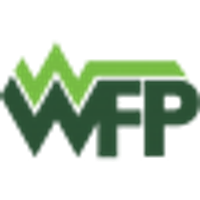
Western Forest Products Inc
TSX:WEF


| US |

|
Johnson & Johnson
NYSE:JNJ
|
Pharmaceuticals
|
| US |

|
Berkshire Hathaway Inc
NYSE:BRK.A
|
Financial Services
|
| US |

|
Bank of America Corp
NYSE:BAC
|
Banking
|
| US |

|
Mastercard Inc
NYSE:MA
|
Technology
|
| US |

|
UnitedHealth Group Inc
NYSE:UNH
|
Health Care
|
| US |

|
Exxon Mobil Corp
NYSE:XOM
|
Energy
|
| US |

|
Pfizer Inc
NYSE:PFE
|
Pharmaceuticals
|
| US |

|
Palantir Technologies Inc
NYSE:PLTR
|
Technology
|
| US |

|
Nike Inc
NYSE:NKE
|
Textiles, Apparel & Luxury Goods
|
| US |

|
Visa Inc
NYSE:V
|
Technology
|
| CN |

|
Alibaba Group Holding Ltd
NYSE:BABA
|
Retail
|
| US |

|
JPMorgan Chase & Co
NYSE:JPM
|
Banking
|
| US |

|
Coca-Cola Co
NYSE:KO
|
Beverages
|
| US |

|
Walmart Inc
NYSE:WMT
|
Retail
|
| US |

|
Verizon Communications Inc
NYSE:VZ
|
Telecommunication
|
| US |

|
Chevron Corp
NYSE:CVX
|
Energy
|
Utilize notes to systematically review your investment decisions. By reflecting on past outcomes, you can discern effective strategies and identify those that underperformed. This continuous feedback loop enables you to adapt and refine your approach, optimizing for future success.
Each note serves as a learning point, offering insights into your decision-making processes. Over time, you'll accumulate a personalized database of knowledge, enhancing your ability to make informed decisions quickly and effectively.
With a comprehensive record of your investment history at your fingertips, you can compare current opportunities against past experiences. This not only bolsters your confidence but also ensures that each decision is grounded in a well-documented rationale.
Do you really want to delete this note?
This action cannot be undone.

| 52 Week Range |
10.26
14.4
|
| Price Target |
|
We'll email you a reminder when the closing price reaches CAD.
Choose the stock you wish to monitor with a price alert.

|
Johnson & Johnson
NYSE:JNJ
|
US |

|
Berkshire Hathaway Inc
NYSE:BRK.A
|
US |

|
Bank of America Corp
NYSE:BAC
|
US |

|
Mastercard Inc
NYSE:MA
|
US |

|
UnitedHealth Group Inc
NYSE:UNH
|
US |

|
Exxon Mobil Corp
NYSE:XOM
|
US |

|
Pfizer Inc
NYSE:PFE
|
US |

|
Palantir Technologies Inc
NYSE:PLTR
|
US |

|
Nike Inc
NYSE:NKE
|
US |

|
Visa Inc
NYSE:V
|
US |

|
Alibaba Group Holding Ltd
NYSE:BABA
|
CN |

|
JPMorgan Chase & Co
NYSE:JPM
|
US |

|
Coca-Cola Co
NYSE:KO
|
US |

|
Walmart Inc
NYSE:WMT
|
US |

|
Verizon Communications Inc
NYSE:VZ
|
US |

|
Chevron Corp
NYSE:CVX
|
US |
This alert will be permanently deleted.
Western Forest Products Inc
Western Forest Products, Inc. is a forest products company, which manufactures wood products and manages forests. The company is headquartered in Vancouver, British Columbia and currently employs 2,051 full-time employees. The company went IPO on 2004-08-03. The Company’s primary business is the sale of lumber and logs, which includes timber harvesting, sawmilling logs into specialty lumber, value-added lumber remanufacturing and wholesaling purchasing lumber. The Company’s product categories include outdoor living, exterior appearance, interior living, structural, industrial, and LIFESTYLE CEDAR. The outdoor living product category offers decking, timbers, outdoor structures, fencing products. The exterior appearance offers siding, trim & fascia, soffits, door & window products. The interior living product category offers Interior paneling, interior moldings, architectural millwork, and stair components. For structural, the Company offers timbers, framing, Japanese housing, and engineered products. For industrial, the Company offers bridge, docks, rail ties, cross arms, and mat stock. The LIFESTYLE CEDAR product category offers decking and fencing.

Western Forest Products, Inc. is a forest products company, which manufactures wood products and manages forests. The company is headquartered in Vancouver, British Columbia and currently employs 2,051 full-time employees. The company went IPO on 2004-08-03. The Company’s primary business is the sale of lumber and logs, which includes timber harvesting, sawmilling logs into specialty lumber, value-added lumber remanufacturing and wholesaling purchasing lumber. The Company’s product categories include outdoor living, exterior appearance, interior living, structural, industrial, and LIFESTYLE CEDAR. The outdoor living product category offers decking, timbers, outdoor structures, fencing products. The exterior appearance offers siding, trim & fascia, soffits, door & window products. The interior living product category offers Interior paneling, interior moldings, architectural millwork, and stair components. For structural, the Company offers timbers, framing, Japanese housing, and engineered products. For industrial, the Company offers bridge, docks, rail ties, cross arms, and mat stock. The LIFESTYLE CEDAR product category offers decking and fencing.
EBITDA Loss: Adjusted EBITDA for the third quarter was negative $65.9 million, significantly worse than last year, mainly due to a $59.5 million non-cash export duty expense.
Major Duty Increases: U.S. softwood lumber duties rose to 35.16% from 14.4%, and a new 10% tariff was imposed on imported lumber, sharply impacting results.
Cost Controls: The company reduced debt by $15.7 million and improved liquidity to $234 million through working capital reductions and a new credit facility.
Volume and Demand Weakness: Lower lumber shipments, a weaker sales mix, and log harvest challenges led to reduced log and lumber inventories.
Production Cuts: Western plans to reduce Q4 lumber production by 35 million board feet in response to high duties, tariffs, and weak demand.
Outlook: Management expects challenging market conditions to persist but is preparing for possible improvement in late Q4 2025 or early 2026.

































